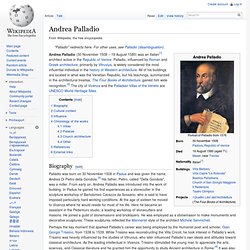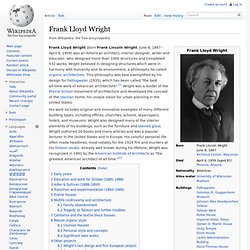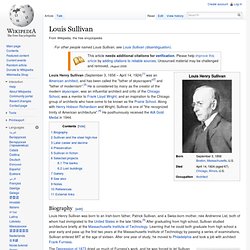

Andrea Palladio. Andrea Palladio (30 November 1508 – 19 August 1580) was an Italian[1] architect active in the Republic of Venice.

Palladio, influenced by Roman and Greek architecture, primarily by Vitruvius, is widely considered the most influential individual in the history of Western architecture. All of his buildings are located in what was the Venetian Republic, but his teachings, summarized in the architectural treatise, The Four Books of Architecture, gained him wide recognition.[2] The city of Vicenza and the Palladian Villas of the Veneto are UNESCO World Heritage Sites.
Biography[edit] Palladio was born on 30 November 1508 in Padua and was given the name, Andrea Di Pietro della Gondola.[3] His father, Pietro, called "Della Gondola", was a miller. From early on, Andrea Palladio was introduced into the work of building. Frank Lloyd Wright. Frank Lloyd Wright (born Frank Lincoln Wright, June 8, 1867 – April 9, 1959) was an American architect, interior designer, writer and educator, who designed more than 1000 structures and completed 532 works.

Wright believed in designing structures which were in harmony with humanity and its environment, a philosophy he called organic architecture. This philosophy was best exemplified by his design for Fallingwater (1935), which has been called "the best all-time work of American architecture".[1] Wright was a leader of the Prairie School movement of architecture and developed the concept of the Usonian home, his unique vision for urban planning in the United States. Early years[edit] Louis Sullivan. Biography[edit] Louis Henry Sullivan was born to an Irish-born father, Patrick Sullivan, and a Swiss-born mother, née Andrienne List, both of whom had immigrated to the United States in the late 1840s.[5] After graduating from high school, Sullivan studied architecture briefly at the Massachusetts Institute of Technology.

Learning that he could both graduate from high school a year early and pass up the first two years at the Massachusetts Institute of Technology by passing a series of examinations, Sullivan entered MIT at the age of sixteen. After one year of study, he moved to Philadelphia and took a job with architect Frank Furness.